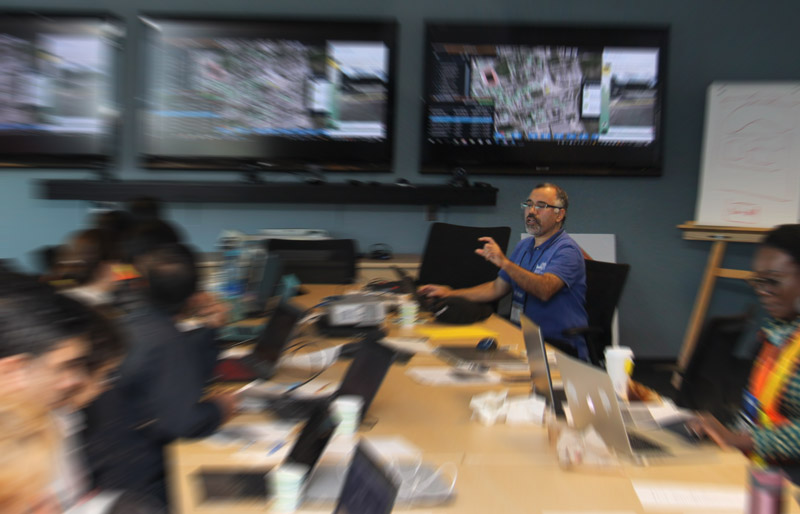The Toronto Transit Commission (TTC) held an emergency exercise Oct. 25 at the York University Station, which is one of two new subway stations on the Keele campus that will be opening Dec. 17.
The exercise was needed to test new emergency response procedures developed in preparation for the subway coming to the Keele campus. There was also a concurrent simulation exercise to ensure the University’s emergency response procedures coordinated with the TTC. The actual simulation took the form of a subway crash with multiple casualties. Some 600 volunteers took part in the simulation, including York University students, staff and faculty, as well as, Toronto Police Services, Toronto Paramedic Services, Toronto Fire Services and the City of Toronto.

Professor Ali Asgary and student participants in the Emergency Operations Centre during at the emergency simulation exercise at York University TTC station, October 25, 2017
“In a real emergency, there’s a lot of moving parts that need to come together quickly. I am happy to say that this simulation exercise was successful thanks to our staff and the many York community members and external partners who worked collaboratively in the planning and delivery of the exercise,” said Samina Sami, executive director, Community Safety Department.
The exercise provided an unprecedented experiential learning opportunity for some 200 York University students.Students from the Disaster and Emergency Management (DEM) program and the Advanced Disaster, Emergency and Rapid Response Simulation (ADERSIM) program participated in the emergency simulation exercise in a number of roles, including as passengers on the train, offering assistance with the exercise logistics at the site of the simulation, as evaluators of the University’s Emergency Operations Centre, and working in a shadow exercise in a simulated Emergency Operations Centre to test new high-tech equipment that will help the University respond more effectively to emergencies in the future.
DEM students apply technologies and learning to the simulation
Students from the Disaster and Emergency Management (DEM) program and Advanced Disaster, Emergency and Rapid Response Simulation (ADERSIM) program participated in the TTC/York exercise in four diverse groups.
“Our collaboration with the Community Safety Department in this emergency simulation exercise helped to inform our work in developing the state of the art modelling and simulation technology for disaster management in ADERSIM (Advanced Disaster, Emergency and Rapid Response Simulation) and provided an invaluable research and training opportunity for our NSERC CREATE program trainees,” said Ali Asgary, associate professor of disaster & emergency Management, and the associate director of ADERSIM.

The York University Station on the Keele campus
For Asgary and his students, the event was a living lab and offered a dynamic learning experience for both the event simulation and the many important roles required to effectively manage an emergency. The students were divided into four teams, each with specific roles and responsibilities. Students prepared for the event by learning about emergency scenarios, the simulation exercise process and components, potential issues that could arise during the simulation and getting to know the environment and future colleagues’ roles in different settings.
The first team was made up of both undergraduate and graduate DEM students who took part in the simulation as passengers on the affected train.
The second team of students participated in the exercise by joining the York Emergency Management team, their role focused on the exercise design process with the York Emergency Management Office that started early in the year. Most of these students also served as exercise evaluators on the day of the exercise. As exercise evaluator, they had to observe the exercise and using the evaluation form assess whether the standard operations procedures were followed.

York students took part in the simulated subway disaster exercise in a number of important ways, from being “injured” to managing the event and providing care
The third team of 16 ADERSIM trainees, comprised of postdoctoral Fellows, doctoral and master’s students from DEM, information technology, engineering, and mathematics, were at the ADERSIM simulation lab (third floor of Kaneff Tower). Students on this team worked on the technologies for several weeks prior to the simulation exercise. Their role during the exercise involved testing some of the ADERSIM emergency management simulation and management technologies as part of a shadow emergency operations centre. The students in the shadow emergency operations centre were divided into the IBM-IO team, the Simulation Team, and the Field Observers Team. The first two teams were located at ADERSIM Simulation Room applying a number of computer simulations developed for the exercise and testing the use of IBM Intelligent Emergency Operations (IBM -IOC) for the exercise. The third team provided real-time information to people working in the York University Emergency Operations Centre, the School of Nursing Simulation Room, and the exercise simulation scene.
The fourth team consisted of two students who were doing their Emergency Management Practicum course with the TTC Emergency Management Office. They were involved in the exercise design process with the TTC as part of their practicum course. The two students on the practicum were heavily involved in preparing and designing this exercise at the TTC level.
All groups took part in a debriefing session known as a hot wash that was conducted right after the exercise. A series of after-action meetings are now being rolled out to further the experiential learning related to the simulation.
Learn more about the Disaster and Emergency Management (DEM) degree for undergraduates, the Master of Disaster and Emergency Management (MDEM) graduate program, and the Certificate in Emergency Management.
